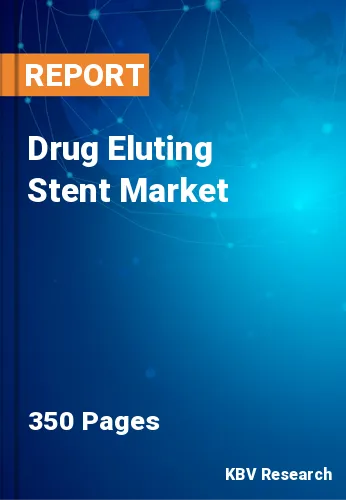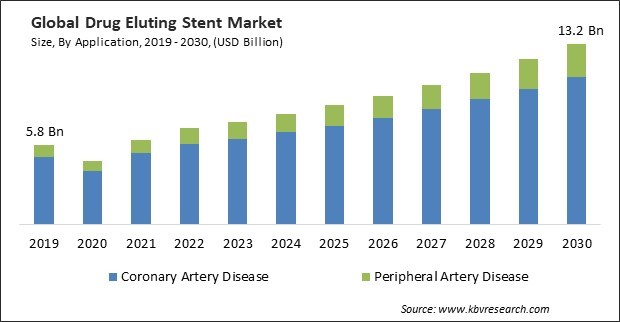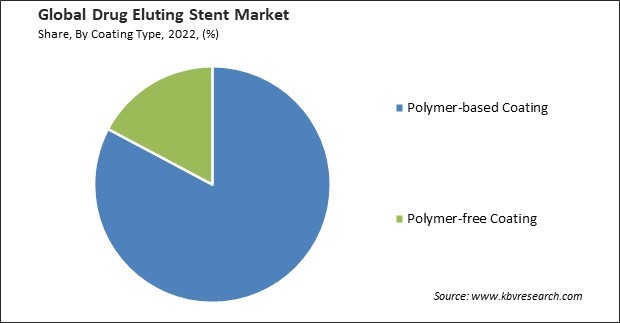
The Global Drug Eluting Stent Market size is expected to reach $13.2 billion by 2030, rising at a market growth of 8.4% CAGR during the forecast period. In the year 2022, the market attained a volume of 14,030.2 thousand units, experiencing a growth of 7.8% (2019-2022).
Non-biodegradable polymers are synthetic materials that do not break down or degrade in the body over time. Consequently, the non-biodegradable polymers segment captured $3,820.5 million revenue in the market in 2022. They are chosen for their stability and durability, which ensures that the drug release profile remains consistent over an extended period. Non-biodegradable polymers are stable and maintain their structural integrity for an extended duration, ensuring the controlled release of drugs over time. These polymers provide a more predictable and consistent drug release profile compared to biodegradable polymers, which may degrade unpredictably. Some of the factors impacting the market are expanding use of minimally invasive techniques, recent modernization of stent technology and Strict regulatory requirements on the use of drug eluting stents.

Small incisions are used in minimally invasive procedures, which have transformed the field of interventional cardiology and are changing how heart diseases are treated. Drug eluting stents offer a highly effective and minimally invasive treatment option for coronary artery disease. These stents are coated with medication to stop the re-narrowing of arteries. This has led to exponential scientific and technological advancements in minimally invasive surgery. Surgeons also had to acquire new surgical methods. These factors will boost the demand in the upcoming years. Additionally, advancements in stent technology have significantly fueled the market. These developments have enhanced stent designs, materials, and coatings, increasing DES's effectiveness, safety, and performance. The danger of inflammation and rejection has decreased by introducing biocompatible materials for stent manufacturing. These stents are designed to administer drugs as effectively as possible while reducing long-term consequences. Therefore, the market is expected to grow rapidly as technologies keep advancing.
However, Strict regulatory clearances may function as a roadblock to the expansion of the market. Numerous authorities and government organizations have established norms and recommendations for effectively and securely using stents. For instance, before approving stents, the U.S. FDA systematically examines the literature and animal pre-clinical trials. The proximal stent border experienced edge restenosis more frequently than the distal stent border, indicating that higher downstream medication concentrations may be protective. These factors can hamper the growth of the market in the future.
Additionally, the pandemic disrupted global supply chains, affecting the production and distribution of medical devices, including DES. Manufacturers faced challenges in sourcing raw materials, transporting products, and meeting demand, leading to supply shortages and delays. Keyways that COVID-19 impacted the economy directly impacted medication and vaccine demand and production, disrupting distribution networks, and an economic impact on businesses and financial sectors. Due to a rise in demand, the COVID-19 pandemic substantially affected the market for these devices. The market for drug eluting stents was impacted by the fact that patients with cardiovascular disorders encountered delays in diagnosis and treatment due to less patient traffic in hospitals and diagnostic centers. As a result, COVID-19 moderately impacted the market.
On the basis of coating type, the market is divided into polymer-based coatings and polymer-free coatings. The polymer-based coating segment procured the largest revenue share in the market in 2022. The efficacy and adaptability of polymer-based coatings are the reason for their dominance in the market. These coatings have been carefully studied and used in developing stents, providing producers with a trustworthy option. Through continuous administration and the prevention of restenosis, the regulated drug release improves patient outcomes. Therefore, the segment will witness lucrative growth opportunities in the future.

The polymer-based coating segment is further subdivided into non-biodegradable polymers and biodegradable polymers. The biodegradable polymers subsegment witnessed a significant revenue share in the market in 2022. A biodegradable polymer coating holds and releases the active component; it will deteriorate and completely absorb over time (often within a year). These tools were created to eliminate the permanent polymer-induced vessel inflammation that is thought to be one of the key contributors to very late safety instances. This will boost the demand in this subsegment.
The polymer-free coating segment is subdivided into micro porous surface, micro structured surface, slotted tubular surface, and nanoporous surface. The micro porous surface subsegment held the maximum revenue share in the market in 2022. The production of polymer-free stents in the market primarily uses micro porous surface technology. Using microporous stent surfaces to control the drug release rate is a strategy that has lately produced some encouraging clinical outcomes. Pits on a microporous surface have dimensions in the order of micrometers in terms of their breadth, depth, and separation. Therefore, the segment will grow considerably in the coming years.
Based on application, the market is bifurcated into coronary artery disease and peripheral artery disease. In 2022, the peripheral artery disease segment recorded a substantial revenue share in the market. The primary growth driver is expected to be the increasing prevalence of peripheral arterial disease (PAD) worldwide. These are widely used in treating PAD due to the growing number of patients suffering from this cardiovascular condition, especially among older adults with risk factors including diabetes and obesity. Owing to this, the segment will grow significantly in the future.
| Report Attribute | Details |
|---|---|
| Market size value in 2022 | USD 7 Billion |
| Market size forecast in 2030 | USD 13.2 Billion |
| Base Year | 2022 |
| Historical Period | 2019 to 2021 |
| Forecast Period | 2023 to 2030 |
| Revenue Growth Rate | CAGR of 8.4% from 2023 to 2030 |
| Number of Pages | 350 |
| Number of Table | 650 | Quantitative Data | Volume in Thousand Units, Revenue in USD Million, and CAGR from 2019 to 2030 |
| Report coverage | Market Trends, Revenue Estimation and Forecast, Segmentation Analysis, Regional and Country Breakdown, Companies Strategic Developments, Company Profiling |
| Segments covered | Coating Type, Application, Region |
| Country scope | US, Canada, Mexico, Germany, UK, France, Russia, Spain, Italy, China, Japan, India, South Korea, Singapore, Malaysia, Brazil, Argentina, UAE, Saudi Arabia, South Africa, Nigeria |
| Growth Drivers |
|
| Restraints |
|
On the basis of region, the drug eluting market is segmented into North America, Europe, Asia Pacific, and LAMEA. The North America segment witnessed the maximum revenue share in the market in 2022. This can be attributed to the region's large patient pool for cardiovascular diseases, which can also be linked to factors like increased reliance on fast food and a sedentary lifestyle, extensive coverage by private and public health insurance providers for stent placement procedures, and an aging elderly population. One of the main factors driving the growth of the North America segment is the increasing prevalence of cardiovascular diseases like peripheral artery disease.
Free Valuable Insights: Global Drug Eluting Stent Market size to reach USD 13.2 Billion by 2030
The market research report covers the analysis of key stake holders of the market. Key companies profiled in the report include Abbott Laboratories, Boston Scientific Corporation, Terumo Corporation, Medtronic PLC, Biosensors International Group, Ltd. (Blue Sail Medical Co., Ltd.), Cook Medical, Inc. (Cook Group), B. Braun Melsungen AG, Biotronik SE & Co. KG, Lepu Medical Technology Co., Ltd and Alvimedica
By Application (Volume, Thousand Units, USD Million, 2019-2030)
By Coating Type (Volume, Thousand Units, USD Million, 2019-2030)
By Geography (Volume, Thousand Units, USD Million, 2019-2030)
This Market size is expected to reach $13.2 billion by 2030.
Expanding use of minimally invasive techniques are driving the Market in coming years, however, Strict regulatory requirements on the use of drug eluting stents restraints the growth of the Market.
Abbott Laboratories, Boston Scientific Corporation, Terumo Corporation, Medtronic PLC, Biosensors International Group, Ltd. (Blue Sail Medical Co., Ltd.), Cook Medical, Inc. (Cook Group), B. Braun Melsungen AG, Biotronik SE & Co. KG, Lepu Medical Technology Co., Ltd and Alvimedica
In the year 2022, the market attained a volume of 14,030.2 thousand units, experiencing a growth of 7.8% (2019-2022).
The Coronary Artery Disease segment is leading the Market by Application in 2022; thereby, achieving a market value of $10.8 billion by 2030.
The North America region dominated the Market by Region in 2022 and would continue to be a dominant market till 2030; thereby, achieving a market value of $5.0 billion by 2030.
Our team of dedicated experts can provide you with attractive expansion opportunities for your business.
